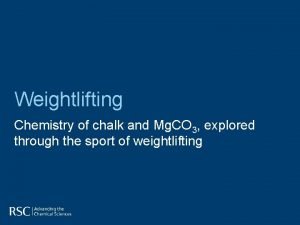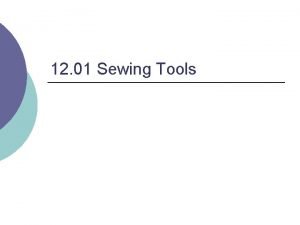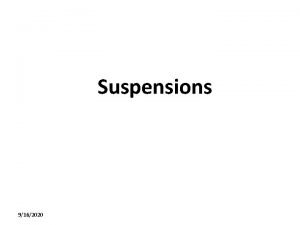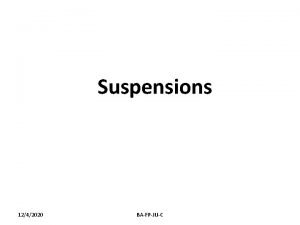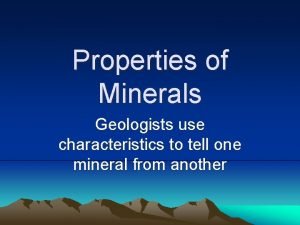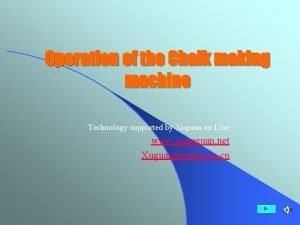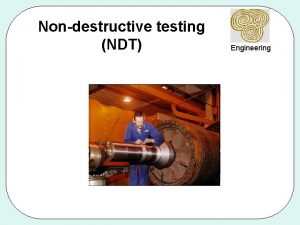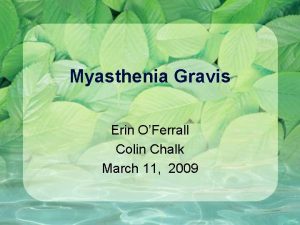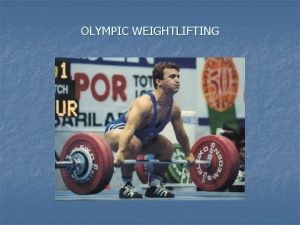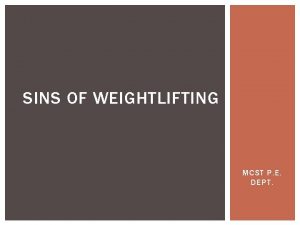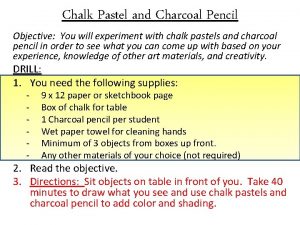Weightlifting Chemistry of chalk and Mg CO 3
















- Slides: 16

Weightlifting Chemistry of chalk and Mg. CO 3, explored through the sport of weightlifting

An introduction to weightlifting The sport of weightlifting can be traced back to ancient times; men would test their strength by lifting, or trying to lift, heavy stones. The sport as we now recognise it originated in Germany in the 1800 s and the International Weightlifting Federation (IWF) was founded in 1905.

Weightlifting and the link to chemistry The lifters use chalk on their hands to aid gripping the bar and to remove moisture, which could cause the bar to slip. Chalk, a naturally occurring or manmade substance, is rich with chemistry and it is here that the link between chemistry and weightlifting can be found.

Chalk in sport Lawn Tennis – line boundaries of court When the ball hits a boundary line it makes a cloud of dust, natural chalk has mostly been replaced with titanium oxide. Gymnastics & rock climbing – stop slipping Similarly to the sport of weightlifting, chalk is applied to hands, arms & legs to stop slipping and absorb moisture. Natural chalk has mostly been replaced with magnesium carbonate here.

Other uses of chalk Other uses include: Small amounts are found in tooth paste, as implements to write with on black boards or for pavement drawings.

The characteristics of chalk Chalk is: § A soft solid § White (sometimes naturally coloured red) Natural chalk is formed in the ground, it is: § Porous sedimentary rock – can hold water § A form of limestone § Composed of the mineral calcite

Natural chalk The formation of natural chalk occurs under deep marine conditions. The gradual accumulation of very small calcite plates shed from marine micro-organisms called coccolithophores causes the formation of the chalk.

Natural chalk Chalk is fairly resistant to erosion compared to clay, another substance often associated with chalk. When clay surrounding chalk is eroded steep cliffs can result. A good example being the white cliffs of Dover. The porous nature of chalk means that it can hold water – this can provide a natural reservoir that releases water slowly in drought.

Manmade chalk Natural chalk has widely been replaced with a manmade chalk called magnesium carbonate. It has similar characteristics to chalk in that it is a white, soft solid. The empirical formula of magnesium carbonate is Mg. CO 3.

Manmade chalk Magnesium carbonate, although used in sport, also has a range of other uses which include being used in: flooring, fireproofing, fire extinguishing, cosmetics, dusting powder, drying agents, and in laxatives for loosening bowels.

Manmade chalk Magnesium carbonate, although occurring naturally as a mineral, is produced through a variety of methods industrially. One way it can be produced is by mixing solutions of magnesium with carbonate ions under an atmosphere of carbon dioxide. Another way it can be produced is by exposing a magnesium hydroxide slurry to carbon dioxide under pressure.

Summary Chalk is widely used in sport and in weightlifting it is used to stop the hands slipping. It helps to increase friction between the hands and the bar. Chalk is formed in deep marine conditions when produced naturally. Most applications of natural chalk in sport have been replaced with manmade magnesium carbonate which has the empirical formula: Mg. CO 3

Summary continued Magnesium carbonate is produced synthetically through various chemical reactions which combine magnesium with carbonate ions under an atmosphere of carbon dioxide, or expose magnesium hydroxide slurry to carbon dioxide under pressure.

Worksheet answers – Q 1 & 2 1. Chalk, when occurring naturally in the ground, comes from a sedimentary rock. Name the sedimentary rock and two other sediments that are sometimes found in this layer of rock. The sedimentary rock that chalk comes from is limestone and other sediments which sometimes occur in limestone include flint and chert. 2. How is natural chalk formed? Chalk is formed under deep marine conditions from the gradual accumulation of very small calcite plates shed from marine microorganisms.

Worksheet answers – Q 3 3. Describe a chemical process used to manufacture magnesium carbonate. Magnesium carbonate can be produced by combining magnesium with carbonate ions under an atmosphere of carbon dioxide. or Magnesium carbonate can be produced by exposing magnesium hydroxide slurry to carbon dioxide. This process needs to take place under pressure.

Worksheet answers – Q 4 4. Name five uses of magnesium carbonate other than in sport. Answers could include: § Fire extinguisher composition § Drying agent § Cosmetics § Dusting powder § Laxatives § Reinforcing agent for neoprene rubber § Flooring
 Ofbca powerlifting
Ofbca powerlifting Men's 100m swim record
Men's 100m swim record Approach chemistry chalk chapter
Approach chemistry chalk chapter Nathan ronen cfa review
Nathan ronen cfa review Heavy duty cutting of fabric
Heavy duty cutting of fabric Chalkdustdiva
Chalkdustdiva Indiffusible solids
Indiffusible solids Paediatric chalk mixture bp
Paediatric chalk mixture bp Metals nonmetals and metalloids chart
Metals nonmetals and metalloids chart Whitaker chalk swindle & schwartz pllc
Whitaker chalk swindle & schwartz pllc Cleavage of chalk
Cleavage of chalk Machine change chalk
Machine change chalk Chalk in vinegar
Chalk in vinegar The golden door ellis island
The golden door ellis island Chalk test in ndt
Chalk test in ndt Colin chalk
Colin chalk Adulterants in food chemistry project
Adulterants in food chemistry project


